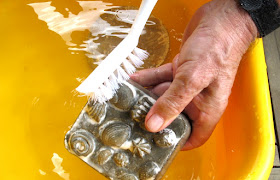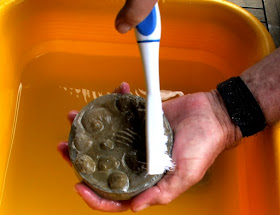 |
| This is the jar I used. It stands 30 cm tall. |
Now you are ready to start planting. For your first attempt, use a jar with a wide mouth, like the one shown in Part 1. This is because because some of your plant choices won't work, and you need to learn to work at a distance.
In time, you will be able to use a bottle with a tiny opening, but for now, you will really appreciate being able to get your hand inside.
All the same, the time has come to learn the craft. For tools, you need a piece of iron wire, long enough to reach the potting mix, a stick to use as a spade, also long enough to reach, and a paper funnel to help you drop seeds where you want them.
 You will also need a long cutting tool to shape the plants in your bottle garden. A razor blade, glued to a long stick will do, but a "box cutter" blade, attached with screws, is the best design.
You will also need a long cutting tool to shape the plants in your bottle garden. A razor blade, glued to a long stick will do, but a "box cutter" blade, attached with screws, is the best design.I used a stick rather longer than the jar, about 50 cm, but I later shortened it to about 40 cm.
 The blades I use have a hole in them as they come out of the packet, and I use a screw through that to hold the blade in place, while the other two screws hold it steady.
The blades I use have a hole in them as they come out of the packet, and I use a screw through that to hold the blade in place, while the other two screws hold it steady.What words are needed? Just follow the pictures! A word of advice, thought: these things can be lethal, so you need to be careful where you leave this, and how you wave it around. Keep it away from pets and small children.
Once you have cut bits off a plant, you need to grab them and drag them out, so now we will make a plant gripper.
You need a stick Once again, I used a piece of timmer that was too long and later trimmed it.
You also need an ordinary spring clothes peg, two screws, and a length of fishing line (plus a drill, a safe bench space to work on (not the best dining table!!!) and two small screws.
The first step is to pull the clothes peg apart like this, then get the drill.
Notice in this next shot how there are now three holes in the peg: two for screws and one for the fishing line. Notice also the matching holes in the stick.
The irregular middle hole came about because I was clumsy with the drill, but it turned out not to be needed anyhow.
Nest step: attach the half peg to the stick.
I started drilling one hole in the other half to attach the fishing line (see above), but in the end, I had trouble getting the fishing line to stop slipping, so I drilled a series of holes (see below).
Then I wound the fishing line through the holes until frictional forces stopped the line slipping.
Then I fitted the two halves of the peg together (see above), and discovered that my design didn't work. So I drilled a new hole, behind the peg, and now it worked:
Well this is my prototype, so see if you can do better!
Planting
You can add some moss, choosing small pieces, dropping them down the paper funnel and tamping them into the potting mix with the wire. For plants, visit the garden centre and choose some tiny 'ground cover' or 'border' plants, or hunt around for some of the small weeds that grow in your garden. For flower seeds, ask about snowdrops, forget-me-nots, Livingstone daisy, Impatiens, Zebrina or Tradescantia. You can also add mosses, liverworts and small ferns.
No room for a bottle? No seeds? Try this: the tops of carrots will sprout and grow if you give them a chance, as you can see here.
To get more ideas for plants, perform a web search on <terrarium plants>. Or you could just make a terrarium.
I am now about to be busy for a few days doing field work, but when I get back, I need to say something about growing ferns from spores.
Now just to finish off, the work described and shown here was originally written as part of a book that comes out on May 1, called Australian Backyard Naturalist, and it got left out on account of a lack of space.
 A secret: books like that take as long in gestation as a baby elephant, and the steps shown in this blog were carried out more than two years ago.
A secret: books like that take as long in gestation as a baby elephant, and the steps shown in this blog were carried out more than two years ago.
Yesterday, I took my garden in a bottle, now more than two years old, took off the lid, and took a shot down into the jar to show the fishbone fern I had planted in it, and then ignored for two years.
This is it!
So as you can see, this sort of setup is seriously low maintenance!















































